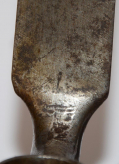site search
online catalog
CONFEDERATE ALTERATION OF A VIRGINIA MANUFACTORY MUSKET BY PERSIGNON: EX-CROMWELL, EX-BEN MICHEL, PUBLISHED ASAC AND BY MURPHY AND MADAUS, WITH A LIKELY VA MANUFACTORY BAYONET

$6,000.00 SOLD
Originally $7,500.00
Quantity Available: None
Item Code: 1000-266
This is a very strong example of a Virginia Manufactory musket converted to percussion by Francis Persignon of Richmond, most likely for the Commonwealth of Virginia between October 1861 and September 1862, during which time he is estimated to have converted 1,850 muskets owned by the state, though may also be one of 325 Virginia muskets he converted for the Confederate Ordnance Department, a point of contention between state and Confederate authorities for a time. Persignon (sometimes misread as Perpignon) was one of six major contractors converting arms for Virginia. The style of conversion used on this musket, a brazed three-faceted bolsters inset in the top edge of the lockplate with a new arsenal-style short spure percussion hammer, along with reassembly marking codes using single Roman numeral in combination with a letter or other Roman numeral, in this case “M” and “XII,” placed in four consistent locations, as well as proportional survival rates, has been convincingly attributed to Persignon. For discussion of these characteristics and the attribution of this very musket, see Murphy and Madaus, Confederate Rifles and Muskets, pages 567-572, and Cromwell’s article in the ASAC. In addition, this musket comes with a well-fitting bayonet that meets criteria for a Virginia Manufactory product.
The musket is in very good condition, with good edges to the wood and a tight fit to the metal, which is brown in color and smooth overall, though with some pitting on top of the breech and on the bolster from firing. Nevertheless, the barrel proof is visible as is county designation “Nansemond,” indicating the musket was originally issued to militia in that county. The lock plate is clearly marked “Richmond / 1803” (2,032 were finished that year) and showing perhaps the tiniest bit of softness from cleaning during the conversion process. The musket is full length in barrel and stock, and complete with all bands, springs, swivels and rod. The metal, including triggerguard, sideplate, barrel, buttplate, bands, etc., shows original assembly numbers (“5.”) Murphy and Madaus note the conversion reassembly number “M” and “XII” stamped on the inner face of the hammer, inner face of the lock on the remnants of the pan/bolster support, underside of the barrel, and the bottom of the stock to the left of the forward strap of the triggerguard, though we have not disassembled the musket to confirm all these locations. The wood has expected dings and handling marks. The only large marks are a set of initials narrowly carved upside down on the right buttstock: “M x C.” The only defect to the metal is a break to the breechplug tang at the screw, leaving about 1-inch to the tip missing.
The bayonet with the musket was cleaned at some point and now shows steel gray with darker gray stains and some pitting. The blade configuration, early French shape but with no fuller, and three-step, L-mortise in a bridged, but not collared socket follows the lines of a VA Manufactory bayonet made about 1811-1815 illustrated Serbaroli (p.33.) It does not have visible mating numbers, but these were often simple filed Roman numbers and the dating would suggest a possible replacement bayonet for an earlier musket. This was likely paired with the musket by Ben Michel, since he sold them together. Research on these is ongoing, but he likely felt there was VA Manufactory connection, was appropriate to the musket, and fits well. We note also the presence of what seems to be crude “I” or “J” stamped on the flat of the blade, similar to a mark pictured by Serberoli (p.32) and identified as the mark of a worker the Manufactory (though that bayonet is earlier) and also the presence of hairline flaws on the socket and blade, which would not have passed US inspectors, but were acceptable at the Manufactory.
This is a great early-war Confederate military conversion musket, needless to say with clear Virginia connections. [sr] [ph:L]
DISCLAIMER: All firearms are sold as collector's items only - we do not accept responsibility as to the shooting safety or reliability of any antique firearm. All firearms are described as accurately as possible, given the restraints of a catalog listing length. We want satisfied customers & often "under" describe the weapons. Any city or state regulations regarding owning antique firearms are the responsibility of the purchaser. All firearms are "mechanically perfect" unless noted, but again, are NOT warranted as safe to fire.
~~~~~~~~~~~~~~~~~~~~~~~~~~~~~~~~~~~
THIS ITEM, AS WITH ALL OTHER ITEMS AVAILABLE ON OUR WEB SITE,
MAY BE PURCHASED THROUGH OUR LAYAWAY PROGRAM.
CLICK HERE FOR OUR POLICIES AND TERMS.
THANK YOU!
Inquire About CONFEDERATE ALTERATION OF A VIRGINIA MANUFACTORY MUSKET BY PERSIGNON: EX-CROMWELL, EX-BEN MICHEL, PUBLISHED ASAC AND BY MURPHY AND MADAUS, WITH A LIKELY VA MANUFACTORY BAYONET
For inquiries, please email us at [email protected]
Most Popular
Historical Firearms Stolen From The National Civil War Museum In Harrisburg, Pa »
Theft From Gravesite Of Gen. John Reynolds »
Selection Of Unframed Prints By Don Troiani »
Fine Condition Brass Infantry Bugle Insignia »
Wonderful Condition Original Confederate-Manufactured Kepi For A Drummer Boy Or Child »
featured item
PRESENTATION SWORD: TWICE WOUNDED IN ACTION, HIS GALLANTRY ON THE BATTLEFIELD SPARED HIM A COURTMARTIAL – CAPT. WM. ACKERMANN, 62ND NEW YORK VOLUNTEERS (ANDERSON ZOUAVES)
This exceptional, silvered Model 1850 staff and field officer’s presentation sword was given to a twice-wounded captain of the Anderson Zouaves by the men of his company. The sword was made by Ball, Black & Co., descended from a New York… (870-138). Learn More »

























